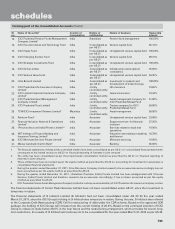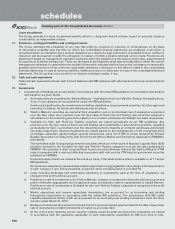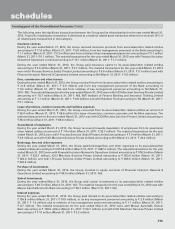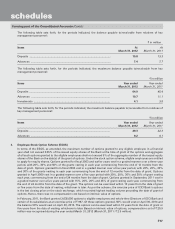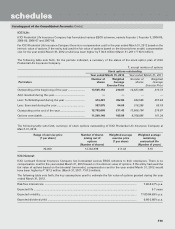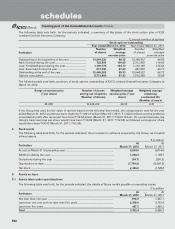ICICI Bank 2012 Annual Report Download - page 150
Download and view the complete annual report
Please find page 150 of the 2012 ICICI Bank annual report below. You can navigate through the pages in the report by either clicking on the pages listed below, or by using the keyword search tool below to find specific information within the annual report.
F72
d. Investments other than mentioned above are valued at cost.
Unrealised gains/losses arising due to changes in the fair value of listed equity shares and mutual fund units are
taken to ’Revenue and other reserves’ in the balance sheet for general insurance business.
The general insurance subsidiary assesses at each balance sheet date whether there is any indication that any
investment in equity or units of mutual fund may be impaired. If any such indication exists, the carrying value of
such investment is reduced to its recoverable amount and the impairment loss is recognised in the revenue(s)/
profit and loss account.
The total proportion of investments for which subsidiaries have applied accounting policies different from the Bank as
mentioned above, is approximately 15.18% of the total investments at March 31, 2012.
14. Provisions/write-offs on loans and other credit facilities
a) All credit exposures, including overdues arising from crystallised derivative contracts, are classified as per RBI
guidelines, into performing and NPAs. Advances held at the overseas branches that are identified as impaired
as per host country regulations but which are standard as per the extent RBI guidelines are identified as NPAs
at a borrower level. Further, NPAs are classified into sub-standard, doubtful and loss assets based on the criteria
stipulated by RBI.
In the case of corporate loans, provisions are made for sub-standard and doubtful assets at the rates prescribed
by RBI. Loss assets and the unsecured portion of doubtful assets are provided for/written off as per the extant RBI
guidelines. For advances booked in overseas branches, which are standard as per the extant RBI guidelines but
are classified as NPAs based on host country guidelines, provisions are made as per the host country regulations.
Provisions on homogeneous retail loans, subject to minimum provisioning requirements of RBI, are assessed at a
borrower level on the basis of days past due.
The Bank holds specific provisions against non-performing loans and general provision against performing loans
and floating provisions taken over from erstwhile Bank of Rajasthan upon amalgamation. The assessment of
incremental specific provisions is made after taking into consideration the existing specific provision held. The
specific provisions on retail loans held by the Bank are higher than the minimum regulatory requirements.
b) Provision on assets restructured/rescheduled is made in accordance with the applicable RBI guidelines on
restructuring of advances by Banks.
In respect of non-performing loan accounts subjected to restructuring, the account is upgraded to standard only
after the specified period i.e. a period of one year after the date when first payment of interest or of principal,
whichever is earlier, falls due, subject to satisfactory performance of the account during the period.
c) Amounts recovered against debts written off in earlier years and provisions no longer considered necessary in the
context of the current status of the borrower are recognised in the profit and loss account.
d) In addition to the specific provision on NPAs, the Bank/the Bank’s housing finance subsidiary maintains a general
provision on performing loans. The general provision covers the requirements of the RBI/NHB guidelines.
e) In addition to the provisions required to be held according to the asset classification status, provisions are held for
individual country exposures (other than for home country exposure). The countries are categorised into seven
risk categories namely insignificant, low, moderate, high, very high, restricted and off-credit and provisioning is
made on exposures exceeding 180 days on a graded scale ranging from 0.25% to 100.00%. For exposures with
contractual maturity of less than 180 days, provision is required to be held at 25.00% of the rates applicable to
exposures exceeding 180 days. If the country exposure (net) of the Bank in respect of each country does not exceed
1.00% of the total funded assets, no provision is required on such country exposure.
f) In the case of the Bank’s housing finance subsidiary, loans and other credit facilities are classified as per the NHB
guidelines into performing and non-performing assets. Further, NPAs are classified into sub-standard, doubtful and
loss assets based on criteria stipulated by NHB. Additional provisions are made against specific non-performing
assets over and above what is stated above, if in the opinion of the management, increased provisions are necessary.
g) In the case of the Bank’s overseas banking subsidiaries, loans are stated net of allowance for credit losses. Loans
are classified as impaired and impairment losses are incurred only if there is objective evidence of impairment as
a result of one or more events that occurred after the initial recognition on the loan (a loss event) and that loss
event (or events) has an impact on the estimated future cash flows of the loans that can be reliably estimated. An
allowance for impairment losses is maintained at a level that management considers adequate to absorb identified
credit related losses as well as losses that have occurred but have not yet been identified.
The total proportion of loans for which subsidiaries have applied accounting policies different from the Bank as
mentioned above, is approximately 11.56% of the total loans at March 31, 2012.
15. Transfer and servicing of assets
The Bank transfers commercial and consumer loans through securitisation transactions. The transferred loans are
de-recognised and gains/losses are accounted for only if the Bank surrenders the rights to benefits specified in the
underlying securitised loan contract. Recourse and servicing obligations are accounted for net of provisions.
In accordance with the RBI guidelines for securitisation of standard assets, with effect from February 1, 2006, the Bank
accounts for any loss arising from securitisation immediately at the time of sale and the profit/premium arising from
forming part of the Consolidated Accounts (Contd.)forming part of the Consolidated Accounts (Contd.)
schedules





